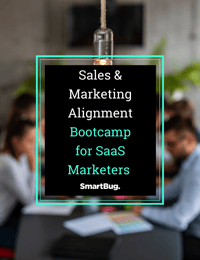
3 Things to Know Before Making your SaaS Product Marketing Plan
February 13, 2019
The SaaS market is going crazy.
Like, 17.3 percent year-over-year market growth—to $85 billion in 2019—kind of crazy.
Helping your SaaS firm grab a piece of that pie might seem daunting at first. But if you resist the urge to create an "all the things, all the time" SaaS product marketing plan, you can succeed. How? Do your homework, and establish these three things before you start planning:
1. Your Hero Statement
Trying to be everything to everyone in that $85 billion SaaS market is a sure-fire way to overextend your resources—probably on a lot of people who aren’t going to buy from you anyway. Instead, pick out the customer segment that’s a perfect match for your SaaS product, and rock every part of that customer experience.
Enter your hero statement, which helps you focus on the right target customers for the right reasons. to It’s a combination of the company profile or persona you serve best with the problem that you’re best at helping them solve. It might sound simple, but it requires a bit of advanced research to get these two elements nailed down:
- Buyer Personas: These are semi-fictional representations of your ideal customers based on market research and real data about your existing customers. If you’re not sure where to start, check out SmartBug’s Ultimate Guide to Inbound Marketing Personas.
- The Jobs You’re Best at: In essence, this is the Jobs-to-be-Done Theory applied to your SaaS product. Thinking along these lines can help you discover which alternatives—including and going beyond your traditional competitors—your target customers are currently using to meet their needs. HubSpot Academy offers an excellent overview of identifying which “jobs to be done” your customers are actually “hiring” your SaaS product to achieve. (Spoiler alert: They might not be the jobs you think.)
Here are some hero statement examples:
- My SaaS firm is a hero to CIOs of $3-10 million companies who need to reduce data storage costs by 25 percent within two years.
- My SaaS firm is a hero to marketing managers at $1-3 million non-profits who want video content to generate over 30 percent of website conversions within the next year.
As you develop your product marketing plan, check your marketing activities and goals against your hero statement to ensure you’re in alignment.
2. Your KPIs
Before you can identify KPI goals for your SaaS marketing plan, you need to identify which specific marketing metrics you’re going to track and how to access them in a repeatable way.
Our e-book on SaaS marketing strategies that deliver quick wins and long-term victory is chock-full of KPIs you might measure across your marketing. But because I’m on the CRO team here at SmartBug, I’ll toot my own horn and stick with the number-one website metric: conversion rates … toot!
Conversion Rates
Having a lot of website visitors is great, especially if your goal is brand awareness. But it’s the actions they take once they’ve arrived that move the needle.
If you’re just starting out, at least establish a repeatable means of tracking conversions—whether form submissions, CTA clicks, or video views—on your most valuable pages. That way, you’ll have some baseline data to measure against all of the specific CRO optimization efforts that you note in your marketing plan.
Best of all? Most common website metrics are directly tied to conversion rates. If you want to get into the weeds on CRO, here’s some advice from my fellow SmartBug, Kristen Patel.
Bonus Points: Try to develop your KPI goals as SMART as you can: Specific, Measurable, Attainable, Realistic, and Timely. Even if you don’t have years’ worth of data to pull from, SMART goals can help you set a baseline to work from next time.
3. Your Sales and Marketing SLA
When creating a successful SaaS product marketing plan, your sales and marketing teams need to be on the same page.
Create this alignment by having both teams commit to a sales and marketing SLA (service-level agreement), which tells the two teams what to expect of each other.
A basic sales and marketing SLA has two parts:
- Marketing must provide a certain number of leads to sales per month.
- Sales must contact those leads within a certain time frame and follow up at regular intervals.
Pro Tip:
Tasking marketing with delivering a certain number of leads per month is a great starting point for your SLA, but it doesn’t account for the quality of those leads. A basic SLA like the one above can still lead to misalignment if marketing provides the required amount of leads, but sales loses interest in contacting them due to poor lead quality.
True alignment comes from tasking both teams with a common goal: revenue. Or to be more specific in the case of your marketing team, average future expected revenue. Starting with your customers, work backwards through the conversion rates of your funnel to determine:
- How much revenue does an average customer represent?
- What percentage of sales demos/trials go on to create new customers?
- How many sales interactions result in a demo/trial?
- What percentage of leads is sales able to contact?
- How many of marketing’s leads does sales interact with, and how soon after receiving them?
- How many leads does marketing send to sales each month?
- How many leads do different marketing activities generate?
It’ll take some time and lots of data to calculate, but with an average future expected revenue goal for your marketing team, you’ll find yourself making better decisions in your product marketing planning.
As you get a better handle on the quality of your leads and how much revenue value they represent on average, you should update your SLA accordingly. For more on creating your SLA, see this SmartBug blog by Amber Kemmis.

About the author
Charly Mostert was formerly an Inbound Marketing Strategist at SmartBug Media. With diverse in-house and agency experience, he loves researching and spreading the word on the newest inbound marketing best practices. Read more articles by Charly Mostert.









